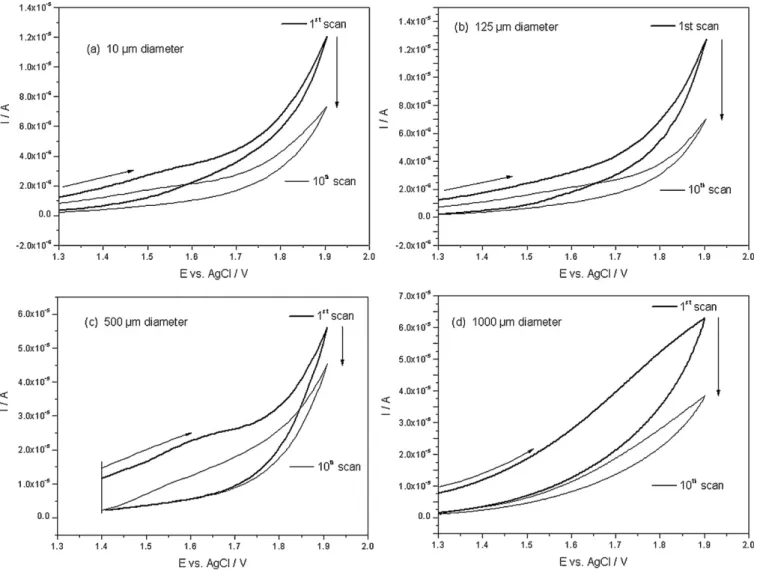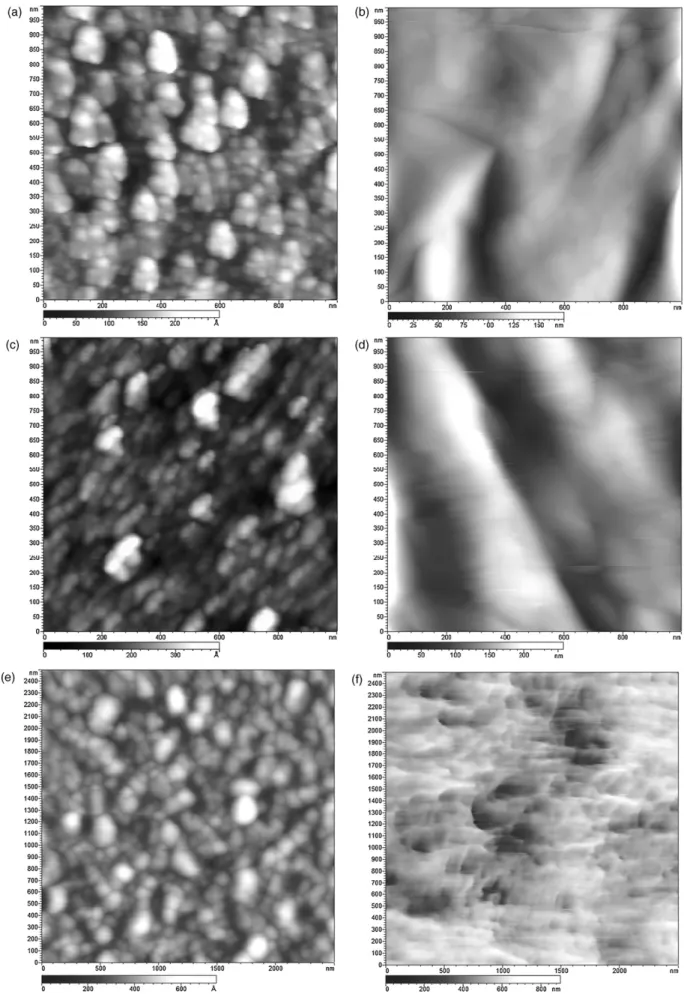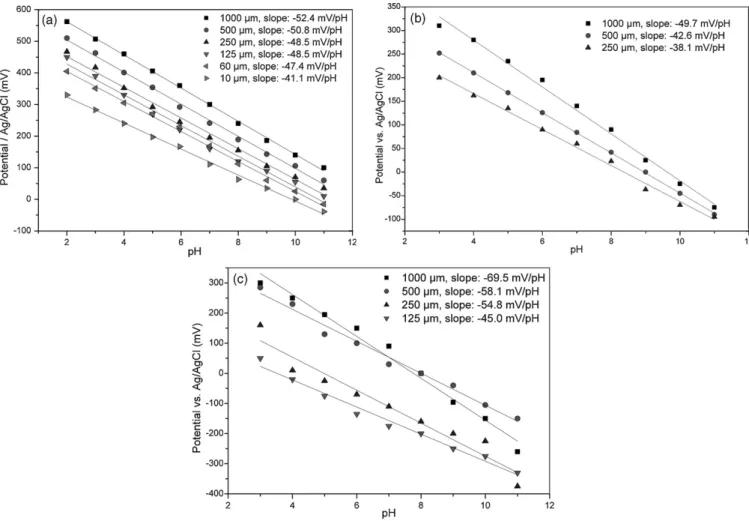HAL Id: hal-00496955
https://hal.archives-ouvertes.fr/hal-00496955
Submitted on 21 Apr 2021
HAL is a multi-disciplinary open access
archive for the deposit and dissemination of
sci-entific research documents, whether they are
pub-lished or not. The documents may come from
teaching and research institutions in France or
abroad, or from public or private research centers.
L’archive ouverte pluridisciplinaire HAL, est
destinée au dépôt et à la diffusion de documents
scientifiques de niveau recherche, publiés ou non,
émanant des établissements d’enseignement et de
recherche français ou étrangers, des laboratoires
publics ou privés.
Distributed under a Creative Commons Attribution| 4.0 International License
One-pot electrosynthesis of polyglycine-like thin film on
platinum electrodes as transducer for solid state pH
measurements
G. Herlem, R. Zeggari, J.-Y. Rauch, S. Monney, F. Torrealba Anzolac„ Y.-C.
Guillaume, C. André, T. Gharbi
To cite this version:
G. Herlem, R. Zeggari, J.-Y. Rauch, S. Monney, F. Torrealba Anzolac„ et al.. One-pot electrosynthesis
of polyglycine-like thin film on platinum electrodes as transducer for solid state pH measurements.
Talanta, Elsevier, 2010, 82 (1), pp.417-481. �10.1016/j.talanta.2010.04.008�. �hal-00496955�
One-pot electrosynthesis of polyglycine-like thin film on platinum
electrodes as transducer for solid state pH measurements
Guillaume Herlem
a,∗, Rabah Zeggari
a, Jean-Yves Rauch
a, Sandrine Monney
b,
Freddy Torrealba Anzola
c, Yves Guillaume
d, Claire André
d, Tijani Gharbi
aaFemto-ST/LOPMD CNRS UMR 6174, 16 route de Gray, 25030 Besancon cedex, France
bDepartment of Chemistry, bat. N, UFR ST, University of Franche-Comté, 16 route de Gray, 25030 Besancon cedex, France cUICM-Departamento de Física, UCLA-Decanato de Ciencias y Tecnología, Av. Las Industrias Km1, Barquisimeto 3001, Venezuela
dLaboratoire de Chimie Analytique et Physique, EA 4267, Place Saint Jacques, UFR SMP, University of Franche-Comté, 25030 Besancon cedex, France
The anodic oxidation of concentrated glycine based aqueous electrolyte on smooth platinum electrode leads to a strongly grafted polyglycine-like coating on the surface in an irreversible way. Due to the proton affinity towards amino groups of polyglycine (PG), the electrodeposited thin film was used as receptor for solid potentiometric pH sensor. In order to reach local pH measurement, we developed miniaturized microelectrodes on glass substrate thanks to photolithography process. We used silver chloride on silver as the reference electrode. The couple (silver chloride, PG based platinum electrode) of microelectrodes gives linear potentiometric response vs. pH in the range [2–12], reversibly and with a sensitivity of 52.4 mV/pH (for 1 mm electrode size). PG based pH electrode is compared to other organic polymer based pH receptor such as linear polyethylenimine (L-PEI), polyaniline (PANI) and glass membrane.
1. Introduction
We have shown that the anodic oxidation of aqueous con-centrated glycine electrolyte yielded polyglycine-like coating on smooth platinum electrode[1]. The anodic oxidation of primary amine probably occurs via a radical cation mechanism which explains the homogeneity of the resulting thin coating observed by atomic force microscopy (AFM).
Glycine, first isolated in 1820 from gelatin, is the simplest amino acid and is the only one that is not optically active (it has no stereoisomer). It is essential for the biosynthesis of nucleic acids as well as porphyrins, creatine phosphate, and other amino acids. This molecule is used in a wide range of applications such as flavor enhancers and maskers, pH buffers and stabilizers, ingredients in pharmaceutical products, and as a chemical intermediate.
PG, the simplest synthetic polypeptide which comes from glycine is known to exist in two different crystalline modifica-tions; polyglycine I (PG I), a planar () zigzag conformation and polyglycine type II (PG II), a helical conformation[2]. PG is also
∗ Corresponding author at: Institute Femto-ST UMR CNRS 6174, University of Franche-Comte, 16 route de Gray, UFR Sciences & Techniques, 25030 Besancon cedex, France. Tel.: +33 3 81 66 62 94.
E-mail address:guillaume.herlem@univ-fcomte.fr(G. Herlem).
involved in many applications such as linkers in molecular biolog-ical techniques and biodegradable nylon polymers. It was shown recently that this polymer can form stable non-covalent struc-tures by self-assembly through intermolecular hydrogen bonding
[3,4].
If PG is produced industrially from years by organic route, the thin film obtained by electrochemical polymerization has similar spectroscopic features with PG II[5]. Its covalent grafting on the electrode surface and the affinity of protons for PGII[6]makes this coating a good candidate for pH receptor. Thus, the aim of this work is to develop and test a whole solid and fast pH sensor based on PG electrodeposition in potentiometric mode for quality control. Moreover, agribusiness and chemistry are pH electrode consuming industries and miniaturized solid state pH sensor can bring new solutions. In addition, the influence of the electrode size from mil-limeter to micrometer range on the response of the pH sensor is examined. PG behavior as pH sensor is also compared to L-PEI and PANI.
2. Experimental
2.1. Design and achievement of the pH sensor
Our aim is the realization of a micro-sensor by the photolithog-raphy process and composed of two microelectrodes deposited on
Fig. 1. Cyclic voltammograms of the polyglycine anodic oxidation on the smooth platinum electrodes of different diameters: (a) 60, (b) 125, (c) 500 and (d) 1000m. Scan rate: 20 mV/s.
a glass plate: one platinum working electrode and one silver elec-trode. Different electrode diameters (1000, 500, 125 and 10 m) were tested. A silica layer is deposited at the final step on the plate excepted on Pt and Ag electrodes that are in contact with the solution to titrate, avoiding electrical leakage (Fig. 1).
2.2. pH receptor preparation
All products were from Sigma–Aldrich (France) and ultra pure water (Milli-Q, Millipore) was used when needed.
Concerning the PG electrodeposition, the electrochemical mod-ification of the working electrode is described elsewhere[1].
The anodic oxidation of pure ethylenediamine electrolyte (charged with NaBF4 10−3M) leading to L-PEI thin film on
plat-inum electrode can be found elsewhere[7]. This coating acted as pH receptor in previous works and was used again in this study[8]. The electrodeposition of PANI on platinum by the anodic oxi-dation of aniline 0.2 M from neutral aqueous electrolytes charged with LiClO42 M was taken from the literature[9].
Prior to pH measurements, all the modified Pt electrodes were conditioned in 0.1 M KCl solutions and kept in this electrolyte when unused.
Electrode potentials in the pH buffered solutions were mea-sured via a high impedance (>10 M) voltmeter/pHmeter (Mettler) with ±1 mV precision. 1 mV causes about 0.02 pH variation in pH
measurement. pH buffer solutions used consisted in sodium citrate solution 20 mM from pH 2 to 6, sodium phosphate 20 mM from pH 7 to 9, sodium hydroxide for pH 10 and a solution of glycine 51 mM, sodium chloride 51 mM, sodium hydroxide 49 mM for pH 11.
Atomic force microscopy (AFM) measurements were performed using a MultiMode AFM microscope controlled by the PicoSPM from Molecular Imaging system (Agilent now) operating in the tapping mode at a frequency of 90 kHz (Al coated Si3N4tip). The
polymer-modified Pt electrode (Pt/Gly, Pt/L-PEI and Pt/PANI) were then placed in oven at 303 K for 4 h before being analyzed by AFM. Ellipsometric measurements were performed via an UVISEL (Horiba, France) phase-modulated spectroscopic ellipsometer in a clean room. The incident angle was set at 70◦ and the light spot
was 1 mm in diameter. The measurements were performed in the spectral range 250–850 nm, with sampling steps of 5 nm.
3. Results and discussion
In addition to the electrodeposition of polyglycine-like coat-ing from the anodic oxidation of concentrated glycine electrolyte, two other amine based compounds were electrodeposited on smooth platinum electrode for comparison purpose: ethylenedi-amine (EDA) and aniline. EDA behaves as both the electrolyte and the monomer to electropolymerize. EDA is aliphatic and has two primary amino groups whereas aniline is aromatic and contains a
Fig. 2. AFM topography (tapping mode) images of (a) the bare smooth Pt electrode, (b) PG electropolymerization on Pt, (c) PEI electropolymerization on Pt, (d) PANI electropolymerization on Pt, (e) the Ag reference electrode and (f) after FeCl3treatment.
secondary amino group. Moreover, aniline has to be dissolved in a co-solvent.
According to cyclic voltammetry measurements performed to obtain the different thin polymer films (PGII, L-PEI and PANI) on smooth Pt (Fig. 2a), 10 scans are sufficient to coat irreversibly the platinum surface for PG (Fig. 2b) and L-PEI (Fig. 2c) modified elec-trodes whereas two scans are carried out for PANI (Fig. 2d) as shown by AFM imaging. The resulting coatings act as proton receptors where the variation of the charge density occurs depending on the proton concentration.
The AgCl reference electrode used in our potentiometric pH sensor instead of silver reference electrode (SRE) avoids Ag+ions
diffusion. Notice that the potential of SRE can change with pH or the presence of Cl−ion, but our sensor is not based on absolute
poten-tial changes referred to pH. The measurement of the pH value of an unknown solution needs this pH measuring chain, consisting of pH indicator electrode and preferably a reference electrode of the second king[10]. This AgCl reference electrode is simple to prepare and reproducible. The FeCl3treatment drastically changes Ag
sur-face (Fig. 2e) where AgCl smooth nodules become sharp as shown
Fig. 2f[11].
The Pt/PG modified electrodes were tested in potentiometric mode as pH receptor when dipped in different buffered solutions at 293 K. At this stage, a particular care must be brought to the whole system (electrodes plus the pH meter) where stray and corrosion currents and poor electric wire shielding are a common source of error. The working electrode size effect was also considered (Fig. 3a). In all the cases shown, there are large potential variations in the considered pH range. At the millimeter scale the
poten-tiometric response is quasi Nernstian (52.4 mV/pH) but decreases down to 41.1 mV/pH for 10 m electrode size which is a loss of sensitivity of about 20%. Despite this smaller sensitivity, pH mea-surements are still possible and reliable with a 10 m electrode size.
Concerning Pt/L-PEI electrodes, the same trends can be observed as for Pt/PG ones since L-PEI has an insulating character too but is stable in a narrower pH range [3–11] than that of PG (Fig. 3b).
Compared to Pt/PG and Pt/PEI-L, Pt/PANI (Fig. 3c) modified electrodes have quasi to sub Nernstian (69.5 mV/pH) behaviors, depending on the electrode size. In fact, the potential response characterizes not only the transduction of proton concentration vs. pH but also the redox sensitivity of PANI to ionic species in the buffered solutions. This chemical environment can lead to doped PANI that switches to conducting state, yielding in return side elec-trochemical reactions responsible for over voltage and then sub Nernstian response. Another drawback in using this redox polymer is its tendency to peel off in acidic medium.
Other important factors to take into account are the response time of the pH measurements, the linear relationship between pH and the modified electrode potential, and the reproducibility. Con-cerning the reversibility of the potentiometric measurements vs. pH, we can notice that the equilibrium potential response time decreases with the decreasing electrode size. In fact, at least two parameters are essential at this stage: the thickness of the poly-mer coating and the electrode area. Ellipsometric measurements have shown that after the electrodeposition process described pre-viously, the PG coating thickness is around 15 nm (Table 1). Beyond this thickness value, the response time is increased and below,
Table 1
The polymer thickness vs. the number of cycles (cyclic voltammetry).
Electrodeposited polymer Number of cycles (cyclic voltammetry) Thickness (nm) PG II 10 15 ± 0.4 L-PEI 10 18 ± 0.4 PANI 2 50 ± 1
the pH sensitivity is decreased. The smaller the electrode size, the smaller the sensitivity (slope). For instance, at the millimeter size, the response time is about 30 s and less than 10 s for 10 m elec-trode size. The response time which is comparable to that of a glass pH electrode with millimeter size electrode (30 s), is shorten dras-tically at the micrometer scale. We adjusted the parameters for the other electropolymerization process in order to have polymer thickness for PEI-L and PANI in the same range than that of PG.
The reversibility of the pH measurement is directly related to this response time. For this reason, we performed reversibility tests on Pt/PG with 10 m size by comparing the potential responses after a pH scan from 2 to 11 and return to 2. No noticeable differ-ence was detected. For Pt/PEI-L and Pt/PANI, the differdiffer-ence is barely noticeable with 10 m electrode size too.
Globally, the potential variations vs. pH of all the modified elec-trodes present a linear response. The linear correlation coefficients are near 1 for Pt/PG and Pt/PEI-L modified electrodes and between 0.93 and 0.98 for Pt/PANI.
The ageing of the Pt/PG electrode was examined by testing the responses of a newly prepared Pt/PG 60 m size over a period of 30 days. The sensitivity of this system is slightly decreased to 42 mV/pH unit with a potential shift of +120 mV, which is suitable for monitoring the pH in the range [2–12]. Notice that the ageing of PANI[12]has a large impact on its electronic properties which is not in favor of its use as pH transducer for a long period of time. 4. Conclusions
We have presented an original work based on the anodic oxi-dation of an aqueous concentrated glycine electrolyte that yields polyglycine-like coating on smooth platinum electrode surface.
This electrocatalyzed reaction occurs on millimetric as well as micrometric size electrodes via microtechnology techniques, lead-ing to a solid polymeric thin film. Due to the presence of several chemical groups on the modified PG electrode and their affinity towards protons, the resulting coating was used as transducer for solid state pH sensor. In addition to PG-like coating, different poly-meric electrodeposited materials were used too such as L-PEI and PANI. From our results, PG and L-PEI coatings used as pH trans-ducer have shown excellent linear potential responses vs. pH. But PG coating gave the best sensibility and a linear response when used with a 60 m microelectrode size. Moreover, we have pre-sented the influence of the electrode size on the pH response. If the sensitivity decreases with time, it is quite stable over a period of 1 month for monitoring pH variations.
Acknowledgment
The authors gratefully acknowledge the Ecos-Nord ANUIES CONACYT program n◦V08P01 (Venezuela) for financial support via
scientific exchanges. References
[1] G. Herlem, S. Monney, V. Blondeau-Patissier, B. Fahys, T. Gharbi, Electrochim. Acta 54 (27) (2009) 6797.
[2] A.V. Kajava, Acta Crystallogr. D55 (1999) 436.
[3] T. Shimizu, M. Kogiso, M. Masuda, J. Am. Chem. Soc. 119 (1997) 6209. [4] T. Shimizu, S. Ohnishi, M. Kogiso, Angew. Chem. Int. Ed. 37 (23) (1998) 3260. [5] K. Tagaa, M.G. Sowa, J. Wanga, H. Etori, T. Yoshida, H. Okabayashi, H.H. Mantsch,
Vib. Spectrosc. 14 (1997) 143.
[6] I.A. Howard, M. Springborg, J. Chem. Phys. 112 (1) (2000) 416.
[7] G. Herlem, K. Reybier, A. Trokourey, B. Fahys, J. Electrochem. Soc. 147 (2) (2000) 597.
[8] G. Herlem, B. Lakard, M. Herlem, B. Fahys, J. Electrochem. Soc. 148 (11) (2001) E435.
[9] J.-L. Camalet, J.-C. Lacroix, T. Dung Nguyen, S. Aeiyach, M.C. Pham, J. Petitjean, P.-C. Lacaze, J. Electroanal. Chem. 485 (2000) 13.
[10] U. Guth, F. Gerlach, M. Decker, W. Oelßner, W. Vonau, J. Solid State Electrochem. 13 (2009) 27.
[11] B.J. Polk, A. Stelzenmuller, G. Mijares, W. MacCrehanb, M. Gaitan, Sens. Actua-tors B 114 (2006) 239.
[12] P. Rannoua, M. Nechtschein, J.P. Travers, D. Berner, A. Woher, D. Djurado, Synth. Metals 101 (1–3) (1999) 734.


